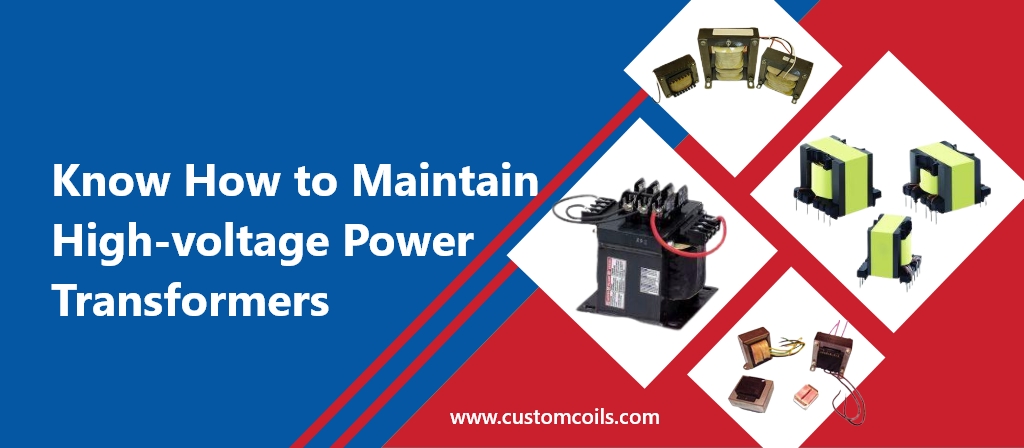High-voltage transformers are integral components in electrical power systems for reliable power transmission and distribution. These transformers allow the step-up or step down of voltages to required levels at power generation plants and in various electrical devices and systems, thus minimizing transmission losses. At most power stations, electricity is generated at a relatively low voltage. The voltage is stepped up to efficiently transfer the electrical power over long distances using these transformers. This stepping-up of voltage reduces the current and energy losses that occur during transmission. Is that all? Obviously not. Are you intrigued to know more about high-voltage power transformers? If yes, then this post is for you. This post mainly highlights the construction and maintenance aspect of these transformers. So, stay tuned.

Discussing Construction of High-voltage Power Transformers
Several components and steps are involved in the construction process of high-voltage power transformers. Here are some relevant pointers.
- Transformer Core: The power transformer’s core is a static device that provides a low-reluctance path for the magnetic flux. It is made using high-quality steel sheets called laminations, which reduces energy losses due to eddy currents and hysteresis. These laminations are insulated using a thin oxide layer to prevent the circulation of eddy currents within the core.
- Windings: The windings of a power transformer have conductive wires, which carry the electric current. They are made of copper or aluminum conductors insulated using polyester, paper, or liquid dielectrics to withstand high-level voltages. There are two types of windings – the primary windings receive the input voltage, and the secondary winding delivers the desired output voltage. The windings must be designed carefully to achieve the desired voltage transformation ratio. It can be arranged in either of the two ways – a concentric arrangement or a sandwich-type arrangement. In the first arrangement, the windings are placed one inside the other, while in a sandwich, they are stacked on top of each other.
- Insulation: It holds great significance in power transformers. How? It helps in preventing electrical breakdown and ensures safe operation. Different materials are used to isolate the core, windings, and other components. Oil-impregnated paper, pressboard, and epoxy are some common insulation materials used. They offer excellent electrical insulation and thermal stability to withstand temperature fluctuations and high voltages during operation.
- Cooling Systems: Incorporating cooling systems in power transformers is important to maintain optimal operating temperature and transformer longevity. Oil-immersed cooling and forced-air cooling are two popular cooling methods. The transformer is immersed in a closed system with oil, acting as a coolant and an electrical insulator. On the other hand, forced-air cooling systems use fans or blowers to circulate air to the surface.
- Protective Enclosure: It is important to protect the power transformers from environmental factors and ensure their efficient operation. This type of enclosure is typically made of high-quality material, such as steel. Thus, it can withstand temperature variations, mechanical stress, vibrations, external contaminants, and more.
How to Maintain High-voltage Power Transformers?
It is of utmost importance to conduct periodic maintenance of high-voltage power transformers to ensure optimal performance, efficient operation, and longevity. Also, it helps identify and address potential issues before it leads to costly failure. The following are some key measures that help maintain these power transformers.
- The first and foremost vital measure to maintain power transformers is regular visual inspection and monitoring. This helps detect physical damage and abnormal operating conditions in early stages. Advanced monitoring techniques should be used to check for potential issues that are not visible to the eyes.
- Next is oil analysis. It is crucial to check the condition of the transformer’s insulation system. Oil sampling and analysis help identify insulation breakdown, signs of degradation, or potential mechanical problems within the power transformer.
- Periodic electrical testing helps measure the insulation integrity and electrical performance of power transformers. Deterioration or abnormalities in the insulation system or windings can be checked by tests such as insulation resistance and power factor.
- It is essential to pay attention to the cooling system of power transformers for proper heat dissipation. Cleaning blowers and verifying the functionality of cooling pumps and radiators help maintain this system in a good condition.
- Bushings and connectors are also prone to degradation over continuous usage. Regular checks ensure that bushings are insulated and free from aging. Connectors must be checked for tightness, corrosion, and any loose or damaged connections.
Power transformers comprise protective devices, such as temperature monitors, pressure relief valves, and so on. They must be inspected for their functionality. If any malfunction is detected, they must be repaired or replaced immediately.
While this information may be useful when sourcing power transformers, it is a good idea to consult an expert in this segment. Also, ensure that you source power transformers from a reliable supplier like Custom Coils. With years of market presence, the company offers premium quality high-voltage power transformers with a good warranty period. The company is ISO 9001:2015 certified and has the expertise and facilities to meet specific requirements for high-voltage power transformers. Contact them today to discuss your requirements, and stay tuned to know more about their upcoming products and events.

